Chuhang Zou
Hybrid Neural-MPM for Interactive Fluid Simulations in Real-Time
May 25, 2025



Abstract:We propose a neural physics system for real-time, interactive fluid simulations. Traditional physics-based methods, while accurate, are computationally intensive and suffer from latency issues. Recent machine-learning methods reduce computational costs while preserving fidelity; yet most still fail to satisfy the latency constraints for real-time use and lack support for interactive applications. To bridge this gap, we introduce a novel hybrid method that integrates numerical simulation, neural physics, and generative control. Our neural physics jointly pursues low-latency simulation and high physical fidelity by employing a fallback safeguard to classical numerical solvers. Furthermore, we develop a diffusion-based controller that is trained using a reverse modeling strategy to generate external dynamic force fields for fluid manipulation. Our system demonstrates robust performance across diverse 2D/3D scenarios, material types, and obstacle interactions, achieving real-time simulations at high frame rates (11~29% latency) while enabling fluid control guided by user-friendly freehand sketches. We present a significant step towards practical, controllable, and physically plausible fluid simulations for real-time interactive applications. We promise to release both models and data upon acceptance.
Direct and Explicit 3D Generation from a Single Image
Nov 17, 2024



Abstract:Current image-to-3D approaches suffer from high computational costs and lack scalability for high-resolution outputs. In contrast, we introduce a novel framework to directly generate explicit surface geometry and texture using multi-view 2D depth and RGB images along with 3D Gaussian features using a repurposed Stable Diffusion model. We introduce a depth branch into U-Net for efficient and high quality multi-view, cross-domain generation and incorporate epipolar attention into the latent-to-pixel decoder for pixel-level multi-view consistency. By back-projecting the generated depth pixels into 3D space, we create a structured 3D representation that can be either rendered via Gaussian splatting or extracted to high-quality meshes, thereby leveraging additional novel view synthesis loss to further improve our performance. Extensive experiments demonstrate that our method surpasses existing baselines in geometry and texture quality while achieving significantly faster generation time.
MonoPatchNeRF: Improving Neural Radiance Fields with Patch-based Monocular Guidance
Apr 12, 2024Abstract:The latest regularized Neural Radiance Field (NeRF) approaches produce poor geometry and view extrapolation for multiview stereo (MVS) benchmarks such as ETH3D. In this paper, we aim to create 3D models that provide accurate geometry and view synthesis, partially closing the large geometric performance gap between NeRF and traditional MVS methods. We propose a patch-based approach that effectively leverages monocular surface normal and relative depth predictions. The patch-based ray sampling also enables the appearance regularization of normalized cross-correlation (NCC) and structural similarity (SSIM) between randomly sampled virtual and training views. We further show that "density restrictions" based on sparse structure-from-motion points can help greatly improve geometric accuracy with a slight drop in novel view synthesis metrics. Our experiments show 4x the performance of RegNeRF and 8x that of FreeNeRF on average F1@2cm for ETH3D MVS benchmark, suggesting a fruitful research direction to improve the geometric accuracy of NeRF-based models, and sheds light on a potential future approach to enable NeRF-based optimization to eventually outperform traditional MVS.
QFF: Quantized Fourier Features for Neural Field Representations
Dec 02, 2022Abstract:Multilayer perceptrons (MLPs) learn high frequencies slowly. Recent approaches encode features in spatial bins to improve speed of learning details, but at the cost of larger model size and loss of continuity. Instead, we propose to encode features in bins of Fourier features that are commonly used for positional encoding. We call these Quantized Fourier Features (QFF). As a naturally multiresolution and periodic representation, our experiments show that using QFF can result in smaller model size, faster training, and better quality outputs for several applications, including Neural Image Representations (NIR), Neural Radiance Field (NeRF) and Signed Distance Function (SDF) modeling. QFF are easy to code, fast to compute, and serve as a simple drop-in addition to many neural field representations.
Deep PatchMatch MVS with Learned Patch Coplanarity, Geometric Consistency and Adaptive Pixel Sampling
Oct 14, 2022



Abstract:Recent work in multi-view stereo (MVS) combines learnable photometric scores and regularization with PatchMatch-based optimization to achieve robust pixelwise estimates of depth, normals, and visibility. However, non-learning based methods still outperform for large scenes with sparse views, in part due to use of geometric consistency constraints and ability to optimize over many views at high resolution. In this paper, we build on learning-based approaches to improve photometric scores by learning patch coplanarity and encourage geometric consistency by learning a scaled photometric cost that can be combined with reprojection error. We also propose an adaptive pixel sampling strategy for candidate propagation that reduces memory to enable training on larger resolution with more views and a larger encoder. These modifications lead to 6-15% gains in accuracy and completeness on the challenging ETH3D benchmark, resulting in higher F1 performance than the widely used state-of-the-art non-learning approaches ACMM and ACMP.
Recurrent Transformer Variational Autoencoders for Multi-Action Motion Synthesis
Jun 14, 2022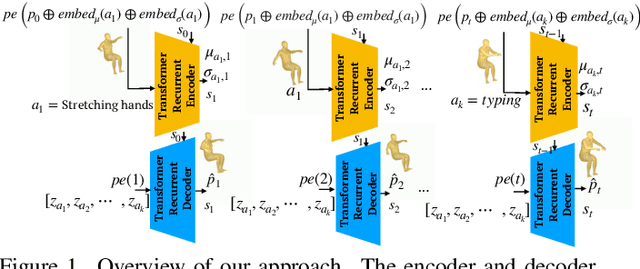
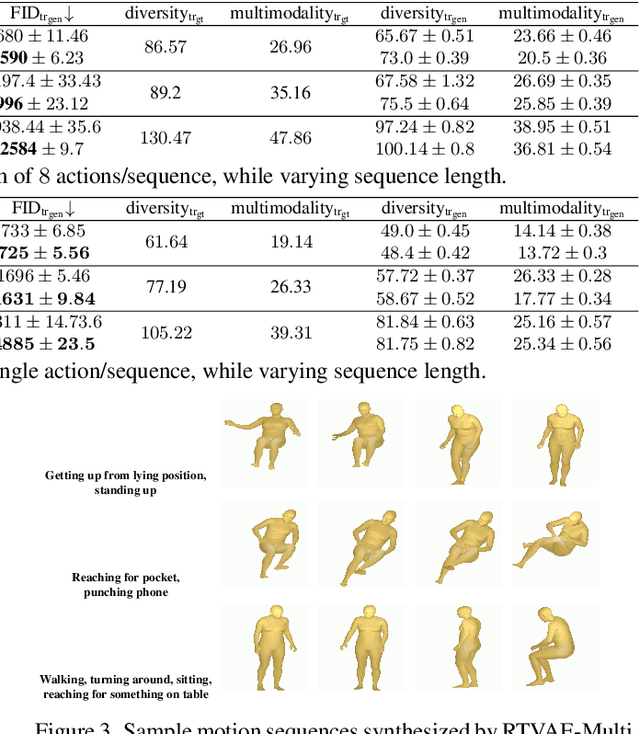
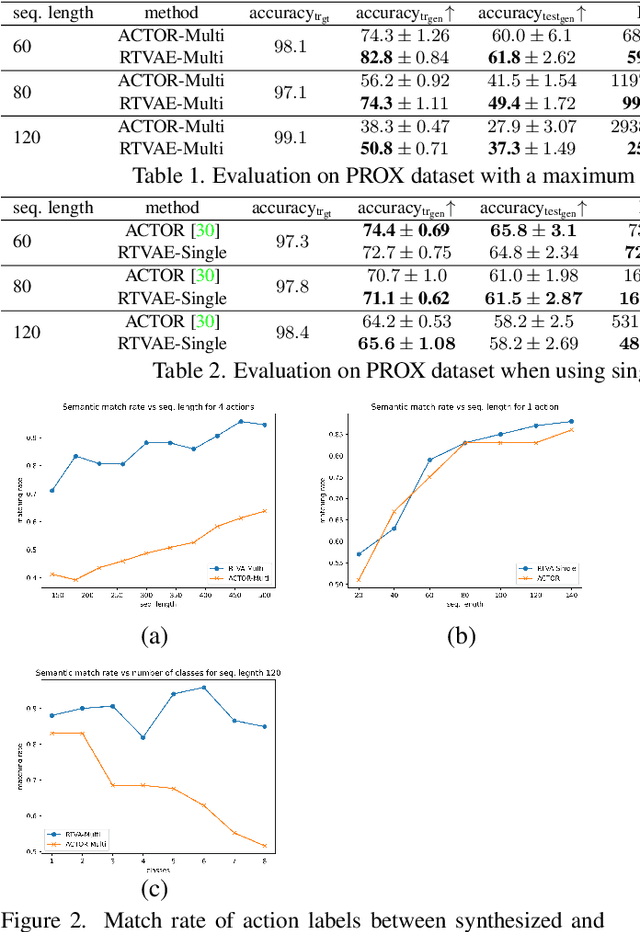

Abstract:We consider the problem of synthesizing multi-action human motion sequences of arbitrary lengths. Existing approaches have mastered motion sequence generation in single-action scenarios, but fail to generalize to multi-action and arbitrary-length sequences. We fill this gap by proposing a novel efficient approach that leverages the expressiveness of Recurrent Transformers and generative richness of conditional Variational Autoencoders. The proposed iterative approach is able to generate smooth and realistic human motion sequences with an arbitrary number of actions and frames while doing so in linear space and time. We train and evaluate the proposed approach on PROX dataset which we augment with ground-truth action labels. Experimental evaluation shows significant improvements in FID score and semantic consistency metrics compared to the state-of-the-art.
PatchMatch-RL: Deep MVS with Pixelwise Depth, Normal, and Visibility
Aug 19, 2021

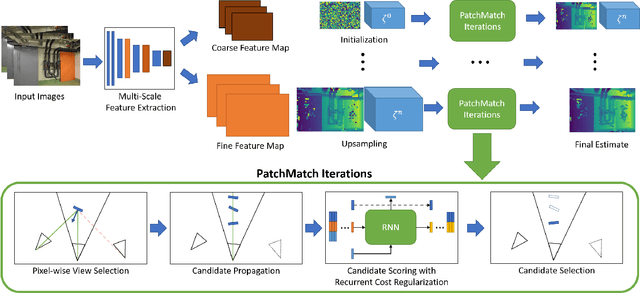

Abstract:Recent learning-based multi-view stereo (MVS) methods show excellent performance with dense cameras and small depth ranges. However, non-learning based approaches still outperform for scenes with large depth ranges and sparser wide-baseline views, in part due to their PatchMatch optimization over pixelwise estimates of depth, normals, and visibility. In this paper, we propose an end-to-end trainable PatchMatch-based MVS approach that combines advantages of trainable costs and regularizations with pixelwise estimates. To overcome the challenge of the non-differentiable PatchMatch optimization that involves iterative sampling and hard decisions, we use reinforcement learning to minimize expected photometric cost and maximize likelihood of ground truth depth and normals. We incorporate normal estimation by using dilated patch kernels, and propose a recurrent cost regularization that applies beyond frontal plane-sweep algorithms to our pixelwise depth/normal estimates. We evaluate our method on widely used MVS benchmarks, ETH3D and Tanks and Temples (TnT), and compare to other state of the art learning based MVS models. On ETH3D, our method outperforms other recent learning-based approaches and performs comparably on advanced TnT.
Multi-Task Learning from Videos via Efficient Inter-Frame Attention
Feb 18, 2020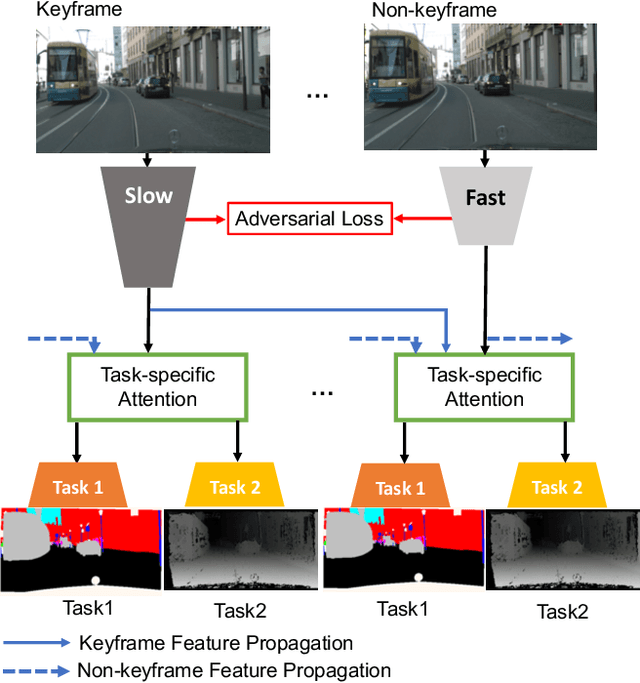
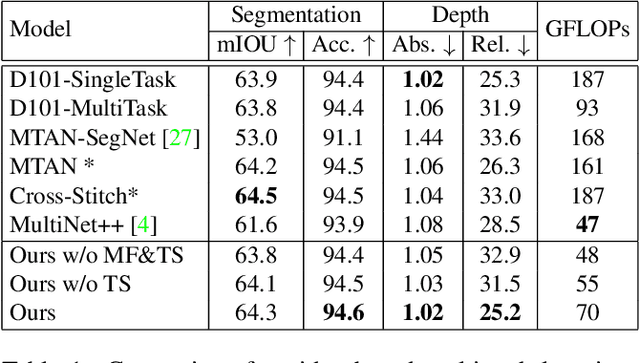
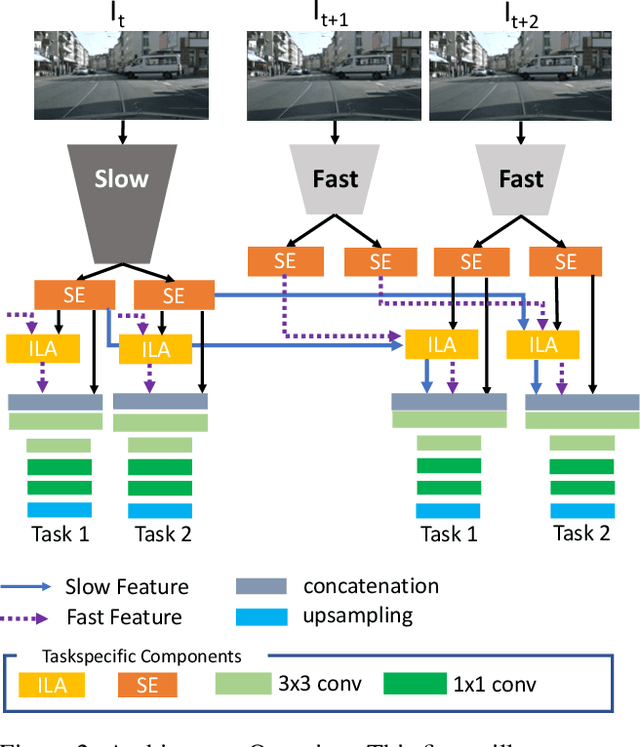

Abstract:Prior work in multi-task learning has mainly focused on predictions on a single image. In this work, we present a new approach for multi-task learning from videos. Our approach contains a novel inter-frame attention module which allows learning of task-specific attention across frames. We embed the attention module in a "slow-fast" architecture, where the slower network runs on sparsely sampled keyframes and the lightweight shallow network runs on non-key frames at a high frame rate. We further propose an effective adversarial learning strategy to encourage the slow and fast network to learn similar features. The proposed architecture ensures low-latency multi-task learning while maintaining high quality prediction. Experiments show competitive accuracy compared to state-of-the-art on two multi-task learning benchmarks while reducing the number of floating point operations (FLOPs) by 70%. Meanwhile, our attention based feature propagation outperforms other feature propagation methods in accuracy by up to 90% reduction of FLOPs.
3D Manhattan Room Layout Reconstruction from a Single 360 Image
Oct 24, 2019



Abstract:Recent approaches for predicting layouts from 360 panoramas produce excellent results. These approaches build on a common framework consisting of three steps: a pre-processing step based on edge-based alignment, prediction of layout elements, and a post-processing step by fitting a 3D layout to the layout elements. Until now, it has been difficult to compare the methods due to multiple different design decisions, such as the encoding network (e.g. SegNet or ResNet), type of elements predicted (e.g. corners, wall/floor boundaries, or semantic segmentation), or method of fitting the 3D layout. To address this challenge, we summarize and describe the common framework, the variants, and the impact of the design decisions. For a complete evaluation, we also propose extended annotations for the Matterport3D dataset, and introduce two depth-based evaluation metrics.
Improving Style Transfer with Calibrated Metrics
Oct 21, 2019



Abstract:Style transfer methods produce a transferred image which is a rendering of a content image in the manner of a style image. We seek to understand how to improve style transfer. To do so requires quantitative evaluation procedures, but the current evaluation is qualitative, mostly involving user studies. We describe a novel quantitative evaluation procedure. Our procedure relies on two statistics: the Effectiveness (E) statistic measures the extent that a given style has been transferred to the target, and the Coherence (C) statistic measures the extent to which the original image's content is preserved. Our statistics are calibrated to human preference: targets with larger values of E (resp C) will reliably be preferred by human subjects in comparisons of style (resp. content). We use these statistics to investigate the relative performance of a number of Neural Style Transfer(NST) methods, revealing several intriguing properties. Admissible methods lie on a Pareto frontier (i.e. improving E reduces C or vice versa). Three methods are admissible: Universal style transfer produces very good C but weak E; modifying the optimization used for Gatys' loss produces a method with strong E and strong C; and a modified cross-layer method has slightly better E at strong cost in C. While the histogram loss improves the E statistics of Gatys' method, it does not make the method admissible. Surprisingly, style weights have relatively little effect in improving EC scores, and most variability in the transfer is explained by the style itself (meaning experimenters can be misguided by selecting styles).
 Add to Chrome
Add to Chrome Add to Firefox
Add to Firefox Add to Edge
Add to Edge